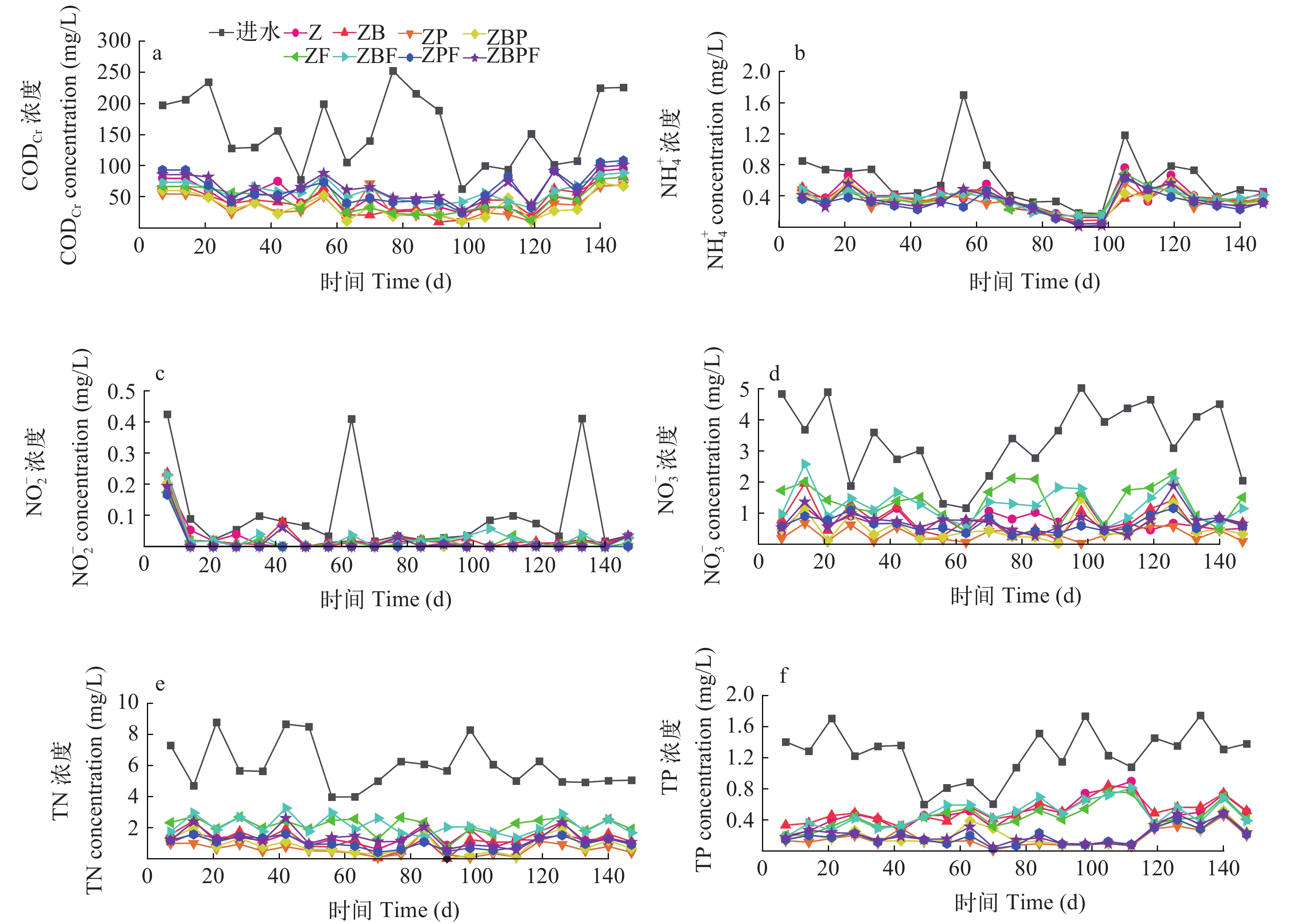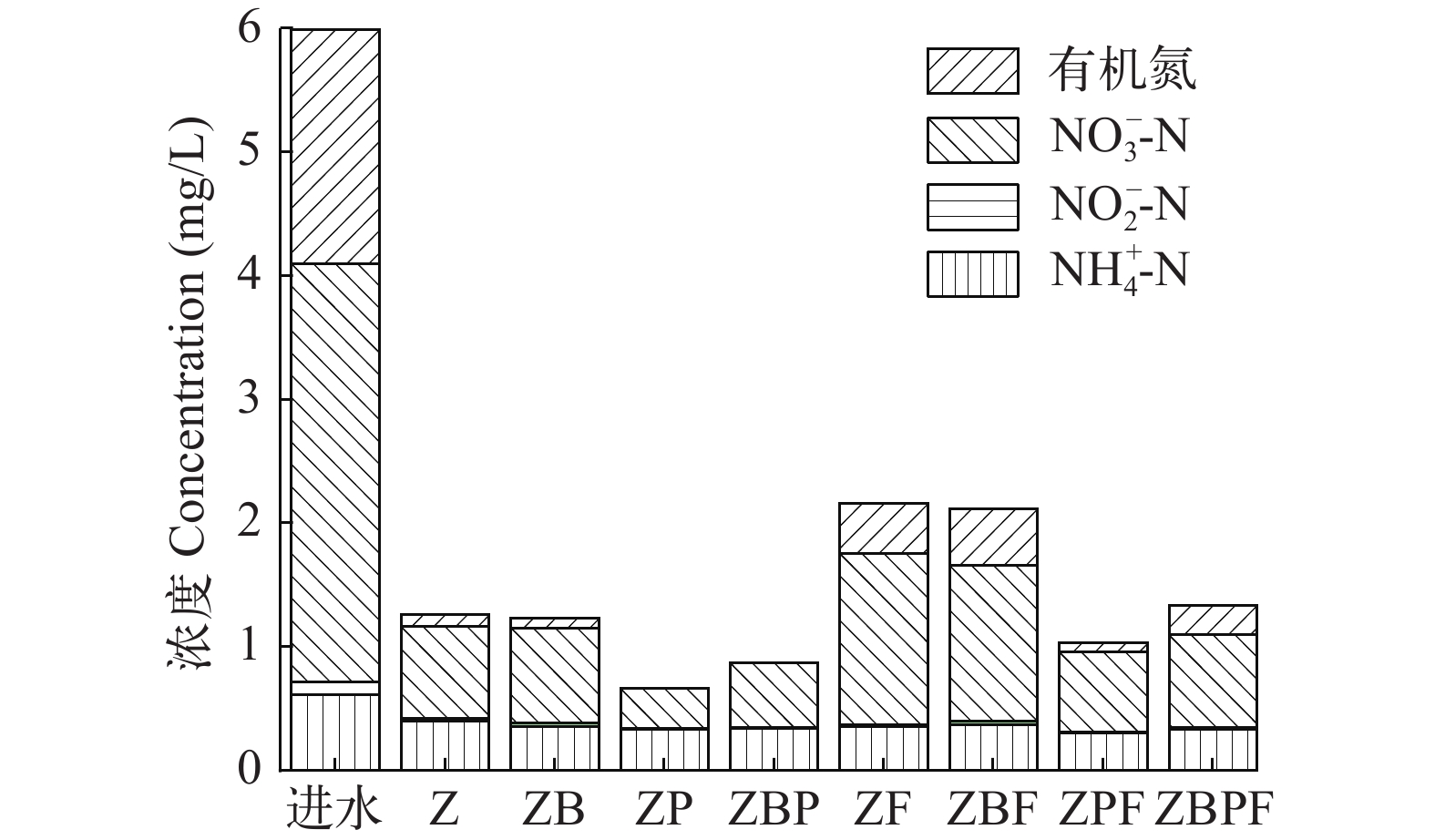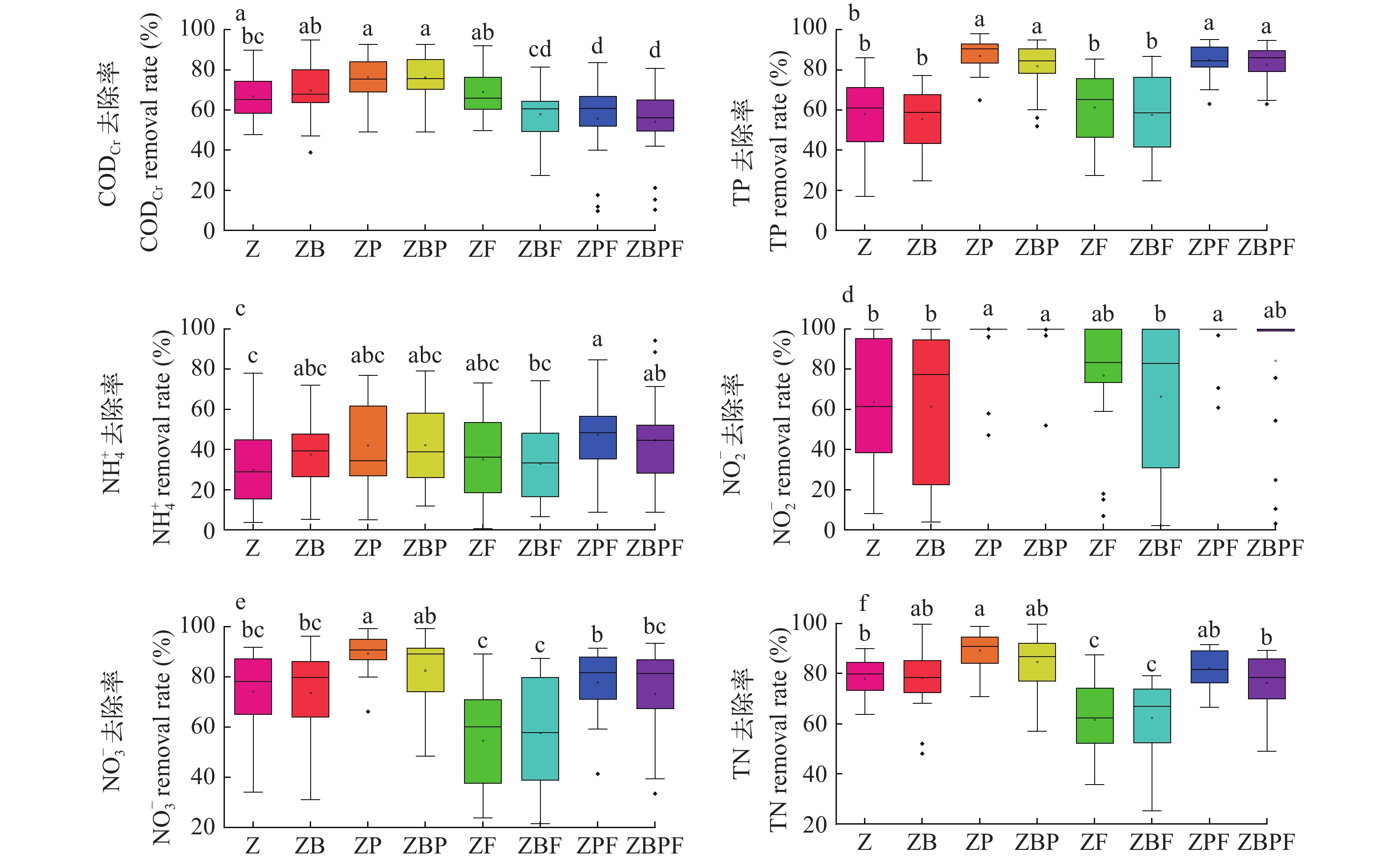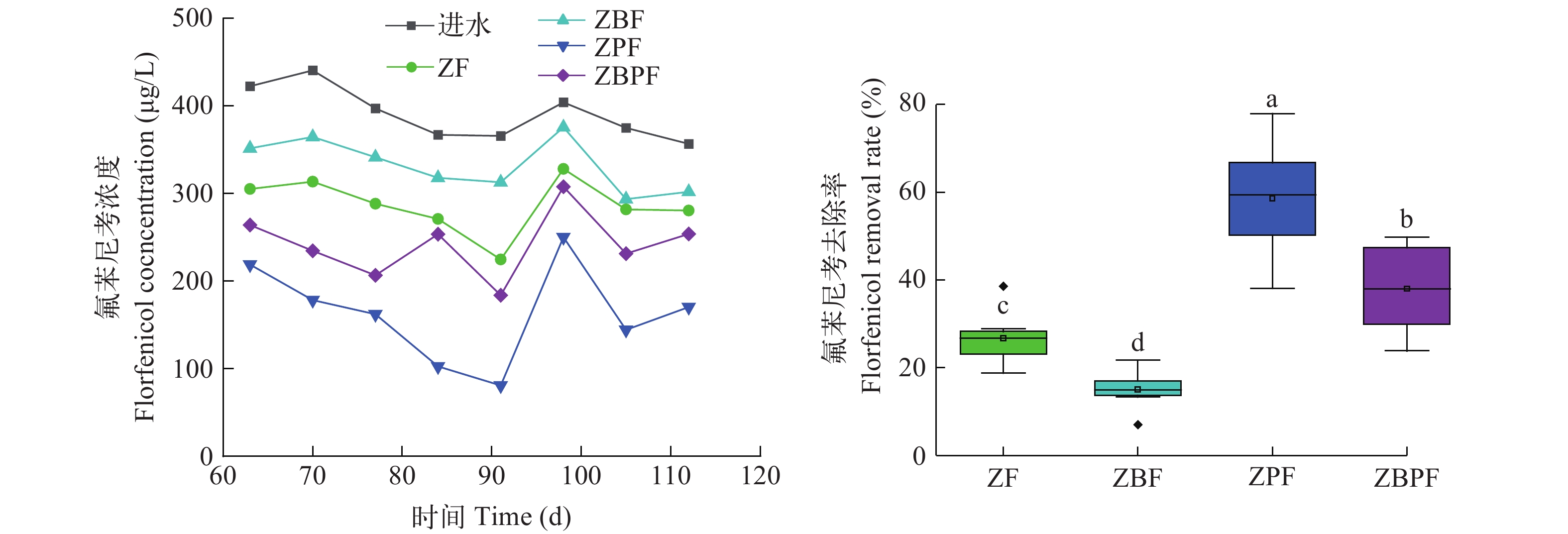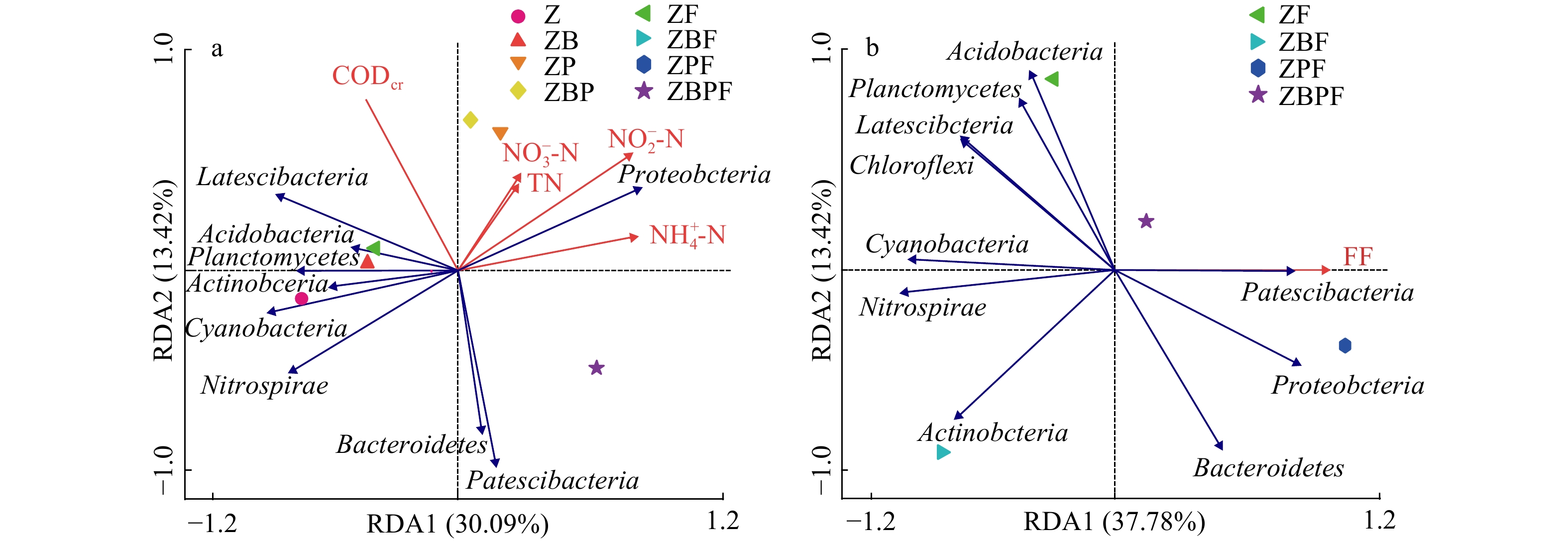ANTIBIOTICS ON THE PURIFICATION OF AQUACULTURE TAILWATER AND MITIGATION PATHWAYS IN CONSTRUCTED WETLANDS
-
摘要:
构建8种不同处理的垂直流人工湿地小试系统净化水产养殖尾水, 探究添加抗生素(氟苯尼考)对人工湿地处理水产养殖尾水中有机物、氮和磷污染物净化效果的影响, 以及基质优化和植物种植对这种影响的缓解途径。结果表明: 垂直流人工湿地对CODCr、TN和TP的去除率分别为54.28%—76.41%、61.60%—89.18%和55.47%—87.00%, 添加抗生素降低了人工湿地对CODCr、${\rm{NO}}^-_3 $-N和TN的去除率分别为11.72%—22.21%、9.23%—19.44%和7.24%—16.40%。种植植物处理组脱氮除磷效果高于没有种植植物处理组, 并且种植植物对人工湿地去除氟苯尼考提高了22.98%—31.87%。添加生物炭对人工湿地去除常规污染物没有显著影响, 降低了对氟苯尼考的去除率。微生物群落结构分析表明抗生素的添加、生物炭的添加和植物的种植对微生物群落结构有显著影响。变形菌门是人工湿地中最主要的优势菌, 在脱氮和去除抗生素过程中发挥着重要作用。髌骨菌门相对丰度在抗生素添加且植物种植处理组中明显提高, 与氟苯尼考去除率显著正相关, 可能是人工湿地去除氟苯尼考的关键门。总体而言, 垂直流人工湿地可以有效的去除水产养殖尾水中的常规污染物和抗生素, 人工湿地植物能协同微生物缓解抗生素污染对人工湿地净化性能的影响。
Abstract:Eight pilot-scale vertical flow constructed wetlands (VFCWs) with different treatments were constructed to purify aquaculture tailwater. The study aimed to assess the effects of adding the antibiotics florfenicol on the removal of organic matter, nitrogen, and phosphorus, as well as to explore mitigation strategies through substrate optimization and planting. The results showed that the removal rates of CODCr, TN, and TP ranged from 54.28% to 76.41%, 61.60% to 89.18%, and 55.47% to 87.00%, and the presence of antibiotics decreased the removal rates of CODCr, ${\rm{NO}}^-_3 $-N, and TN by 11.72% to 22.21%, 9.23% to 19.44%, and 7.24% to 16.40%, respectively. IVCWs with plant exhibited higher nitrogen and phosphorus removal efficiencies compared to those without plant. Notably, planting significantly enhanced the removal rate of florfenicol by 22.98% to 31.87%. While the addition of biochar did not significant effect the removal of conventional pollutants, it decreased the removal rate of florfenicol. Antibiotic addition, biochar addition, and planting had significant effects on microbial community structure. Proteobacteria was the most dominant bacterial phylum in VFCWs, playing a crucial role in nitrogen and antibiotic removal. The relative abundance of Patescibacteria was higher in IVCWs with florfenicol addition and planting than others, which was significantly and positively correlated with florfenicol removal, and might be the key phylum for the removal of florfenicol. Overall, VFCWs could effectively remove conventional pollutants and antibiotics from aquaculture tailwater, and plants could synergize with microorganisms to mitigate negative effects of antibiotic on the pollutants removal capacity of VFCWs.
-
-
表 1 人工湿地对水产养殖尾水中常规污染物和抗生素净化效果比较
Table 1 Comparison of the purification effect of conventional pollutants and antibiotics in aquaculture tailwater in constructed wetlands
人工湿地设计参数
Design parameter of constructed wetland水质指标
Water quality indicator进水浓度
Influent concentration去除率
Removal rate参考文献
Reference流态: 垂直流 COD 190—280 mg/L 11%—61% [7] 基质: 沙﹕沉积物为2﹕1 ${\rm{NH}}^+_4 $-N 166—252 mg/L >61%—94% 植物: 芦苇 ${\rm{NO}}^-_2 $-N 86—415 mg/L >98%—99% 进水: 海水养殖尾水 ${\rm{NO}}^-_3 $-N 453—801 mg/L >86% 水力停留时间: 7d TP 11—26 mg/L >85% 恩诺沙星 100 µg/L >99% 土霉素 100 µg/L >99% 流态: 水平流 COD (49±17) mg/L 39%/40% [8] 基质: 碎石﹕沸石为3﹕1 ${\rm{NH}}^+_4 $-N (1.02±0.30) mg/L 71%/73% 植物: 黄菖蒲或芦苇 ${\rm{NO}}^-_2 $-N (0.05±0.02) mg/L 86% 进水: 水产养殖场河道 ${\rm{NO}}^-_3 $-N (1.49±0.23) mg/L 4%—60%/– 46%— –3% 水力停留时间: 1d/2d/3d/4d TN (2.79±0.41) mg/L 49%/24% TP (0.19±0.11) mg/L 73% 恩诺沙星 (67±51) ng/L — 磺胺甲噁唑 (85±36) ng/L 8%—48%/1%—60% 氟苯尼考 (613±205) ng/L — 流态: 水平流或复合垂直流 COD 61 mg/L — [9] 基质: 碎石﹕沸石为3﹕1 ${\rm{NH}}^+_4 $-N 1.26 mg/L >60% 植物: 芦苇 ${\rm{NO}}^-_2 $-N 0.10 mg/L >95% (>3d) 进水: 水产养殖场河道 ${\rm{NO}}^-_3 $-N 0.80 mg/L >75% (4d) 水力停留时间: 1d/2d/3d/4d TN 3.13 mg/L 53%/58% (3d) TP 0.25 mg/L — 恩诺沙星 75 ng/L — 磺胺甲噁唑 98 ng/L 4%—59%/3%—55% 氟苯尼考 556 ng/L — 流态: 垂直流 阿奇霉素、克拉霉素、红霉素 100 ng/L >87% [10] 基质: 沉积物﹕沙为1﹕2 头孢氨苄、头孢噻呋、克林霉素、恩诺沙星、氧氟沙星、甲氧苄啶 100 ng/L 100% 植物: 芦苇 进水: 水产养殖尾水 水力停留时间: 7d 流态: 水平流 COD (66.60±6.44) mg/L — [11] 基质: 碎石﹕沸石为3﹕1 ${\rm{NH}}^+_4 $-N (2.35±0.56) mg/L 61%—92% 植物: 黄菖蒲或芦苇 ${\rm{NO}}^-_2 $-N (0.13±0.03) mg/L — 进水: 水产养殖尾水 ${\rm{NO}}^-_3 $-N (0.51±0.01) mg/L — 水力停留时间: 3d TN (3.60±1.31) mg/L 73%—91% TP (0.23±0.05) mg/L — 恩诺沙星 26—67 ng/L 76%—81% 磺胺甲噁唑 64—211 ng/L 54%—69% 流态: 垂直流 COD 100 mg/L 100% [12] 基质: 沸石 ${\rm{NH}}^+_4 $-N 8 mg/L 34%—100% 植物: 盐地碱蓬 TIN 20 mg/L 68%—97% 进水: 模拟海水养殖尾水 磺胺甲噁唑 100 µg/L 30%—57% 水力停留时间: 1d 流态: 垂直流 COD (326±22) mg/L 69%—76% [13] 基质: 砂/砾石/沸石 ${\rm{NH}}^+_4 $-N (0.70±0.16) mg/L –175%—54% 植物: 芦苇/美人蕉/黄菖蒲 TN (10.00±1.10) mg/L 4%—40% 进水: 模拟水产养殖尾水 TP (1.17±0.11) mg/L 52%—85% 水力停留时间: 1d/2d/3d 甲氧苄啶 (6.41±0.68) mg/L 89%±3% 磺胺甲噁唑 (6.61±0.51) mg/L 61%±7% 磺胺甲氧嘧啶 (5.74±0.17) mg/L 20%±8% 磺胺二甲嘧啶 (3.33±0.28) mg/L 20%±9% 磺胺嘧啶 (15.50±0.30) mg/L 12%±13% 流态: 垂直流 氟苯尼考 238.78—257.5 µg/L 12%—67% [14] 基质: 沸石或沸石和
生物炭土霉素 237—250 µg/L >85% 植物: 没有或海马齿 氧氟沙星 255—309 µg/L >85% 进水: 淡水养殖尾水 磺胺甲噁唑 250—271 µg/L 8%—67% 水力停留时间: 3d 注: —表示无相关数据Note: — means no relevant date 表 2 不同处理微生物丰富度和多样性
Table 2 Microbial richness and diversity by different treatments
处理组Treatment ACE Chao 1 Simpson Shannon Z 1601.44c 1635.63bc 0.9877b 8.43d ZB 1660.31bc 1682.40b 0.9958a 9.05a ZP 1589.85c 1617.63c 0.9785c 8.15e ZBP 1739.94a 1758.86a 0.9891b 8.70c ZF 1621.63bc 1635.14bc 0.9861b 8.43d ZBF 1604.46c 1630.29bc 0.9928ab 8.71c ZPF 1483.38d 1506.54d 0.9558d 7.68f ZBPF 1670.96b 1685.91b 0.9946a 8.94b -
[1] Food and Agriculture Organization of the United Nations. The State of World Fisheries and Aquaculture 2022, Towards Blue Transformation [R]. Rome: Food and Agriculture Organization of the United Nations, 2022: 5-46.
[2] Cabello F C. Heavy use of prophylactic antibiotics in aquaculture: a growing problem for human and animal health and for the environment [J]. Environmental Microbiology, 2006, 8(7): 1137-1144. doi: 10.1111/j.1462-2920.2006.01054.x
[3] Liu X, Steele J C, Meng X Z. Usage, residue, and human health risk of antibiotics in Chinese aquaculture: a review [J]. Environmental Pollution, 2017(223): 161-169.
[4] Mo W Y, Chen Z, Leung H M, et al. Application of veterinary antibiotics in China’s aquaculture industry and their potential human health risks [J]. Environmental Science and Pollution Research, 2017, 24(10): 8978-8989. doi: 10.1007/s11356-015-5607-z
[5] Lulijwa R, Rupia E J, Alfaro A C. Antibiotic use in aquaculture, policies and regulation, health and environmental risks: a review of the top 15 major producers [J]. Reviews in Aquaculture, 2020, 12(2): 640-663. doi: 10.1111/raq.12344
[6] Lyu J, Yang L, Zhang L, et al. Antibiotics in soil and water in China–a systematic review and source analysis [J]. Environmental Pollution, 2020(266): 115147.
[7] Bôto M, Almeida C, Mucha A. Potential of constructed wetlands for removal of antibiotics from saline aquaculture effluents [J]. Water, 2016, 8(10): 465. doi: 10.3390/w8100465
[8] 黄翔峰, 王珅, 陈国鑫, 等. 人工湿地对水产养殖废水典型污染物的去除 [J]. 环境工程学报, 2016, 10(1): 12-20.] Huang X F, Wang S, Chen G X, et al. Typical pollutants removal efficiency from aquaculture wastewater by using constructed wetlands [J]. Chinese Journal of Environmental Engineering, 2016, 10(1): 12-20. [
[9] 刘佳, 易乃康, 熊永娇, 等. 人工湿地构型对水产养殖废水含氮污染物和抗生素去除影响 [J]. 环境科学, 2016, 37(9): 3430-3437.] Liu J, Yi N K, Xiong Y J, et al. Effect of constructed wetland configuration on the removal of nitrogen pollutants and antibiotics in aquaculture wastewater [J]. Environmental Science, 2016, 37(9): 3430-3437. [
[10] Gorito A M, Ribeiro A R, Gomes C R, et al. Constructed wetland microcosms for the removal of organic micropollutants from freshwater aquaculture effluents [J]. Science of the Total Environment, 2018(644): 1171-1180. doi: 10.1016/j.scitotenv.2018.06.371
[11] Huang X F, Ye G Y, Yi N K, et al. Effect of plant physiological characteristics on the removal of conventional and emerging pollutants from aquaculture wastewater by constructed wetlands [J]. Ecological Engineering, 2019(135): 45-53. doi: 10.1016/j.ecoleng.2019.05.017
[12] Chen J, Gao M, Zhao Y, et al. Nitrogen and sulfamethoxazole removal in a partially saturated vertical flow constructed wetland treating synthetic mariculture wastewater [J]. Bioresource Technology, 2022(358): 127401. doi: 10.1016/j.biortech.2022.127401
[13] Deng Y Y, Zou M Y, Liu W, et al. Antibiotic removal and microbial response mechanism in constructed wetlands treating aquaculture wastewater containing veterinary drugs [J]. Journal of Cleaner Production, 2023(394): 136271. doi: 10.1016/j.jclepro.2023.136271
[14] 岳琛, 欧欢, 张雪婷, 等. 垂直潜流人工湿地对水产养殖尾水中抗生素和氮磷的去除及其影响因素 [J]. 环境工程学报, 2023, 17(4): 1243-1251.] doi: 10.12030/j.cjee.202211136 Yue C, Ou H, Zhang X T, et al. Analysis of influence factors on antibiotics and nutrients removal from aquaculture wastewater by vertical flow constructed wetlands [J]. Chinese Journal of Environmental Engineering, 2023, 17(4): 1243-1251. [ doi: 10.12030/j.cjee.202211136
[15] Liu X, Guo X, Liu Y, et al. A review on removing antibiotics and antibiotic resistance genes from wastewater by constructed wetlands: Performance and microbial response [J]. Environmental Pollution, 2019(254): 112996. doi: 10.1016/j.envpol.2019.112996
[16] Ohore O E, Qin Z, Sanganyado E, et al. Ecological impact of antibiotics on bioremediation performance of constructed wetlands: Microbial and plant dynamics, and potential antibiotic resistance genes hotspots [J]. Journal of Hazardous Materials, 2022(424): 127495. doi: 10.1016/j.jhazmat.2021.127495
[17] Cui E, Zhou Z, Gao F, et al. Roles of substrates in removing antibiotics and antibiotic resistance genes in constructed wetlands: a review [J]. Science of the Total Environment, 2023(859): 160257. doi: 10.1016/j.scitotenv.2022.160257
[18] 周品成, 刘希强, 康兴生, 等. 4种水生植物对兽用抗生素去除效果比较 [J]. 华南农业大学学报, 2019, 40(6): 67-73.] doi: 10.7671/j.issn.1001-411X.201901020 Zhou P C, Liu X Q, Kang X S, et al. Removal effects of four aquatic plants on veterinary antibiotics [J]. Journal of South China Agricultural University, 2019, 40(6): 67-73. [ doi: 10.7671/j.issn.1001-411X.201901020
[19] Lin J, Zhang K, Jiang L, et al. Removal of chloramphenicol antibiotics in natural and engineered water systems: Review of reaction mechanisms and product toxicity [J]. Science of the Total Environment, 2022(850): 158059.
[20] Guo X, Chen H, Tong Y, et al. A review on the antibiotic florfenicol: Occurrence, environmental fate, effects, and health risks [J]. Environmental Research, 2024(244): 117934. doi: 10.1016/j.envres.2023.117934
[21] He P, Wu J, Peng J, et al. Pharmaceuticals in drinking water sources and tap water in a city in the middle reaches of the Yangtze River: occurrence, spatiotemporal distribution, and risk assessment [J]. Environmental Science and Pollution Research, 2022, 29(2): 2365-2374. doi: 10.1007/s11356-021-15363-7
[22] 武俊梅, 魏琳, 彭晶倩, 等. 长江中游典型饮用水水源中药物的时空分布及风险评价 [J]. 环境科学, 2022, 43(6): 2996-3004.] Wu J M, Wei L, Peng J Q, et al. Spatiotemporal distribution and risk assessment of pharmaceuticals in typical drinking water sources in the middle reaches of the Yangtze River [J]. Environmental Science, 2022, 43(6): 2996-3004. [
[23] Saeed T, Sun G. A comprehensive review on nutrients and organics removal from different wastewaters employing subsurface flow constructed wetlands [J]. Critical Reviews in Environmental Science and Technology, 2017, 47(4): 203-288. doi: 10.1080/10643389.2017.1318615
[24] Londoño Y A, Rodríguez D C, Peñuela G. The operation of two EGSB reactors under the application of different loads of oxytetracycline and florfenicol [J]. Water Science and Technology, 2012, 66(12): 2578-2585. doi: 10.2166/wst.2012.485
[25] Wu X, Wu H, Mao L, et al. Influence of florfenicol on the treatment effect of intermittent aeration dynamic membrane bioreactors, and its enhanced removal process investigation [J]. Water, Air, & Soil Pollution, 2016, 227 (11): 418.
[26] Nyer S C, Volkenborn N, Aller R C, et al. Nitrogen transformations in constructed wetlands: a closer look at plant-soil interactions using chemical imaging [J]. Science of the Total Environment, 2022(816): 151560. doi: 10.1016/j.scitotenv.2021.151560
[27] Tong X, Wang X, He X, et al. Effects of ofloxacin on nitrogen removal and microbial community structure in constructed wetland [J]. Science of the Total Environment, 2019(656): 503-511. doi: 10.1016/j.scitotenv.2018.11.358
[28] Yuan Q, Zhang H, Qin C, et al. Impact of emerging pollutant florfenicol on enhanced biological phosphorus removal process: Focus on reactor performance and related mechanisms [J]. Science of the Total Environment, 2023(859): 160316. doi: 10.1016/j.scitotenv.2022.160316
[29] 赵建伟, 袁庆江, 秦丞志, 等. 氟苯尼考降低生物除磷性能的影响行为及机制解析 [J]. 环境科学学报, 2023, 43(5): 116-124.] Zhao J W, Yuan Q J, Qin C Z, et al. Behavior and mechanism analysis of florfenicol Influence on biological phosphorus removal performance [J]. Acta Scientiae Circumstantiae, 2023, 43(5): 116-124. [
[30] 江昊飞, 李慷, 石文智, 等. 常用渔药及水体pH对生物质炭填料系统硝化作用和微生物群落结构的影响 [J]. 水产学报, 2022, 46(9): 1656-1668.] Jiang H F, Li K, Shi W Z, et al. Effects of common fishery drugs and water pH on nitrification performance and microbial community structure of biochar filler system [J]. Journal of Fisheries of China, 2022, 46(9): 1656-1668. [
[31] Carvalho P N, Basto M C P, Almeida C M R, et al. A review of plant-pharmaceutical interactions: from uptake and effects in crop plants to phytoremediation in constructed wetlands [J]. Environmental Science and Pollution Research International, 2014, 21(20): 11729-11763. doi: 10.1007/s11356-014-2550-3
[32] Hu X, Xie H, Zhuang L, et al. A review on the role of plant in pharmaceuticals and personal care products (PPCPs) removal in constructed wetlands [J]. The Science of the Total Environment, 2021(780): 146637. doi: 10.1016/j.scitotenv.2021.146637
[33] Ohore O E, Zhang S, Guo S, et al. Ciprofloxacin increased abundance of antibiotic resistance genes and shaped microbial community in epiphytic biofilm on Vallisneria spiralis in mesocosmic wetland [J]. Bioresource Technology, 2021(323): 124574. doi: 10.1016/j.biortech.2020.124574
[34] Ohore O E, Zhang S, Guo S, et al. The fate of tetracycline in vegetated mesocosmic wetlands and its impact on the water quality and epiphytic microbes [J]. Journal of Hazardous Materials, 2021(417): 126148. doi: 10.1016/j.jhazmat.2021.126148
[35] Xu J, Liu X, Lv Y, et al. Response of Cyperus involucratus to sulfamethoxazole and ofloxacin-contaminated environments: Growth physiology, transportation, and microbial community [J]. Ecotoxicology and Environmental Safety, 2020(206): 111332. doi: 10.1016/j.ecoenv.2020.111332
[36] Wang H, Xu J, Sheng L. Purification mechanism of sewage from constructed wetlands with zeolite substrates: a review [J]. Journal of Cleaner Production, 2020(258): 120760.
[37] 杨大杰, 刘翔, 李炳华, 等. 不同基质人工湿地去除尾水中环丙沙星性能研究 [J]. 人民长江, 2023, 54(12): 58-64.] Yang D J, Liu X, Li B H, et al. Removal of ciprofloxacin removal from tail water by constructed wetlands with different substrates [J]. Yangtze River, 2023, 54(12): 58-64. [
[38] El Barkaoui S, Mandi L, Aziz F, et al. A critical review on using biochar as constructed wetland substrate: Characteristics, feedstock, design and pollutants removal mechanisms [J]. Ecological Engineering, 2023(190): 106927. doi: 10.1016/j.ecoleng.2023.106927
[39] Deng C, Huang L, Liang Y, et al. Response of microbes to biochar strengthen nitrogen removal in subsurface flow constructed wetlands: Microbial community structure and metabolite characteristics [J]. Science of the Total Environment, 2019(694): 133687. doi: 10.1016/j.scitotenv.2019.133687
[40] Ansola G, Arroyo P, Sáenz de Miera L E. Characterisation of the soil bacterial community structure and composition of natural and constructed wetlands [J]. Science of the Total Environment, 2014(473): 63-71.
[41] Kersters K, De Vos P, Gillis M, et al. Introduction to the Proteobacteria [M]. The Prokaryotes. New York: Springer New York, 2006: 3-37.
[42] Kielak A M, Barreto C C, Kowalchuk G A, et al. The ecology of acidobacteria: moving beyond genes and genomes [J]. Frontiers in Microbiology, 2016(7): 744.
[43] Guo F, Zhang J, Yang X, et al. Impact of biochar on greenhouse gas emissions from constructed wetlands under various influent chemical oxygen demand to nitrogen ratios [J]. Bioresource Technology, 2020(303): 122908. doi: 10.1016/j.biortech.2020.122908
[44] Shan A, Wang W, Kang K J, et al. The removal of antibiotics in relation to a microbial community in an integrated constructed wetland for tail water decontamination [J]. Wetlands, 2020, 40(5): 993-1004. doi: 10.1007/s13157-019-01262-8



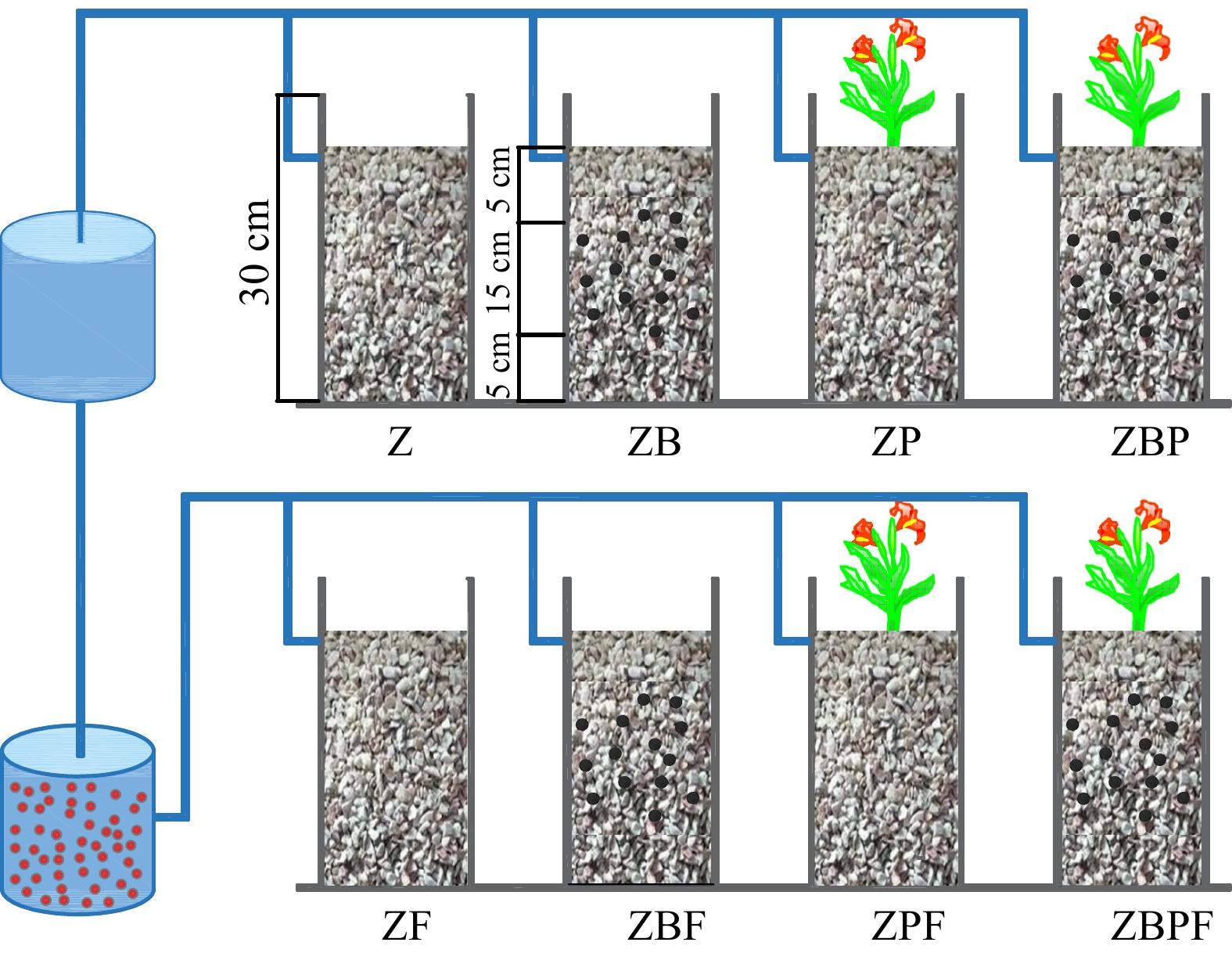
 下载:
下载:
